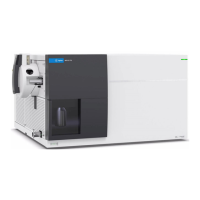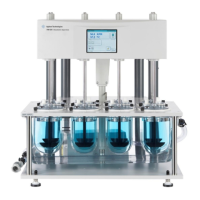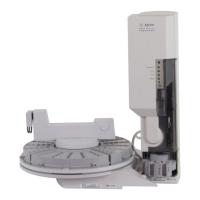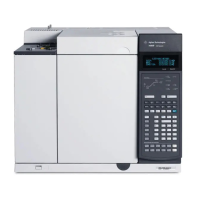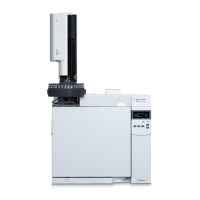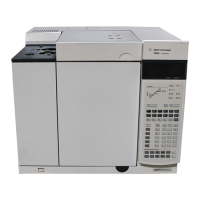140 Troubleshooting and Maintenance Manual
6 Vacuum System
Turbo Pump and Fan
The turbo pump is bolted directly to the bottom of the manifold.
The main inlet to the turbo pump is under the front analyzer. A secondary
inlet is near the ion source. The pump body is a central shaft or cylinder. Sets
of small blades (airfoils) radiate from the central shaft. The shaft spins at up
to 60,000 revolutions per minute (rpm).
Turbo pumps move gas by momentum transfer. The turbine blades are angled
so that when they strike a gas molecule it is deflected downward. Each set of
blades pushes the gas molecules further down toward the pump outlet.
The foreline pump is connected by a hose to the outlet of the turbo pump. It
removes the gas molecules that reach the outlet.
A controller regulates current to the pump and monitors pump motor speed
and temperature. A cooling fan is located between the turbo pump and the
front panel of the MS. The fan draws air from outside the MS and blows it over
the pump.
The turbo pump turns on automatically when the foreline pump has reduced
the pressure below 300 mTorr. The system allows the analyzer to be turned on
when the turbo pump is greater than 80% speed, but the pump normally
operates at 100% speed. Turbo pump MSs typically maintain an indicated
pressure below 8 × 10
-5
Torr for helium column flows up to 4 mL/minute.
The turbo pump spins up (starts) and spins down (stops) quickly. This
simplifies pumpdown and venting. From initial power-on, the system can
pump down to operating pressure in 5 to 10 minutes.
See Also
• To pump down the MS (See the Agilent 7000 Series Triple Quad GC/MS
Operation Manual.)
• To vent the MS (See the Agilent 7000 Series Triple Quad GC/MS Operation
Manual.)

